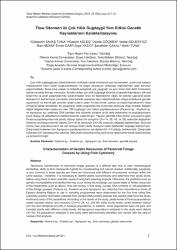| dc.contributor.author | Savaş Tuna, Gülsemin | |
| dc.contributor.author | Keleş, Hüseyin | |
| dc.contributor.author | Göçmen, Damla | |
| dc.contributor.author | Güleryüz, Vesile | |
| dc.contributor.author | Nizam, İlker | |
| dc.contributor.author | Cabi, Evren | |
| dc.contributor.author | Tuna, Metin | |
| dc.date.accessioned | 2022-05-11T14:14:23Z | |
| dc.date.available | 2022-05-11T14:14:23Z | |
| dc.date.issued | 2016 | |
| dc.identifier.issn | 1302-4310 | |
| dc.identifier.issn | 2146-8176 | |
| dc.identifier.uri | https://app.trdizin.gov.tr/makale/TWpNM05qQTJOZz09 | |
| dc.identifier.uri | https://hdl.handle.net/20.500.11776/5883 | |
| dc.description.abstract | Çok yıllık buğdaygil yem bitkisi türlerinin morfolojik olarak birbirlerine çok benzemeleri, aralarında kolaycamelezlenerek hibrit türler oluşturabilmeleri ve doğal varyasyon sebebiyle teşhislerinde ciddi sorunlaryaşanmaktadır. Buna ilave olarak bu türlerde polyploidi çok yaygındır ve aynı türün dahi farklı kromozomsayılarına sahip formları mevcuttur. Bundan dolayı çok yıllık buğdaygil türlerine ait genetik kaynakların bilimselaraştırma ve ıslah çalışmalarında kullanılmadan önce tür teşhislerinin doğru bir şekilde yapılarak ploididüzeylerinin belirlenmesi zorunludur. Aksi taktirde yapılacak olan melezlemelerde ortaya çıkabilecek genetikuyuşmazlık ve kısırlık gibi sorunlar araştırıcıların zaten kıt olan emek, zaman ve maddi kaynaklarının hebaolmasına sebep olmaktadır. Bu çalışmada, ıslah programlarında kullanmak amacıyla Doğu Anadolu Bölgesidağlık bölgelerinden toplanmış olan 169 buğdaygil yem bitkisi popülasyonunun (Festuca sp., Koeleria sp.ve Agropyron sp.) çekirdek DNA içerikleri flow sitometri yöntemi ile ilk defa belirlenmiş ve popülasyonlarınploidi düzeyi ile safiyetlerinin belirlenmesinde kullanılmıştır. Yapılan çekirdek DNA analizi sonuçlarına göreFestuca popülasyonlarında ploidy düzeyi diploid ile octoploid (2n=14, 28, 42, ve 56) arasında değişirkenKoeleria popülasyonlarında diploid (2n=14) ile tetraploid (2n=28) arasında değiştiği belirlenmiştir. Bununlabirlikte bazı popülasyonların ise saf olmayıp farklı ploidy düzeyine sahip bitkilerden oluştuğu saptanmıştır.Çalışmada incelenen tüm Agropyron popülasyonlarının ise diploid (2n=14) olduğu belirlenmiştir. Çalışmadakullanılan tüm popülasyonlar çekirdek DNA analiz sonuçlarınında yardımıyla taksonomik olarak teşhis edilmişve isimlendirilmiştir. | en_US |
| dc.description.abstract | Taxonomic identification of perennial forage grasses is a difficult task due to their morphologicalsimilarities, ability to form interspecific hybrids by crossbreeding and natural variation. Additionally, polyploidyis very common in those species and there are individuals with different chromosome numbers within thesame species. Therefore, it is necessary to identify plants taxonomically and determine their ploidy levelsbefore using them in basic scientific research and plant breeding projects. Otherwise, the problems such asgenetic incompatibility and sterility that may occur during the crossings can cause waste of limited resourcesof the researchers such as labour, time and money. In this study, nuclear DNA contents of 169 populationsof the forage grasses (Festuca sp, Koeleria sp and Agropyron sp) collected from mountainous areas ofEastern Anatolia Region to use in breeding programmes were determined for the first time using flowcytometry and the information obtained from nuclear DNA content analysis was used to determine the ploidylevels and purity of the populations. According to the results of the study, ploidy levels of Festuca populationsvaried between diploid and octoploid (2n=14, 28, 42, and 56) while ploidy levels varied between diploid(2n=14) and tetraploid (2n=28) in Koeleria populations. In addition, some populations were not pure andincluded plants with different ploidy levels. All Agropyron populations analysed in the study were diploid(2n=14). All populations analysed in the study were taxonomically identified and named with the help ofnuclear DNA analysis. | en_US |
| dc.language.iso | tur | en_US |
| dc.rights | info:eu-repo/semantics/openAccess | en_US |
| dc.subject | Biyoloji | en_US |
| dc.title | Flow Sitometri ile Çok Yıllık Buğdaygil Yem Bitkisi Genetik Kaynaklarının Karakterizasyonu | en_US |
| dc.title.alternative | Characterisation of Genetic Resources of Perennial Forage Grasses by Using Flow Cytometry | en_US |
| dc.type | article | en_US |
| dc.relation.ispartof | Tarla Bitkileri Merkez Araştırma Enstitüsü Dergisi | en_US |
| dc.department | Fakülteler, Fen Edebiyat Fakültesi, Biyoloji Bölümü | en_US |
| dc.department | Fakülteler, Ziraat Fakültesi, Tarla Bitkileri Bölümü | en_US |
| dc.identifier.volume | 25 | en_US |
| dc.identifier.issue | Özel sayı-2 | en_US |
| dc.identifier.startpage | 7 | en_US |
| dc.identifier.endpage | 12 | en_US |
| dc.institutionauthor | Keleş, Hüseyin | |
| dc.institutionauthor | Göçmen, Damla | |
| dc.institutionauthor | Güleryüz, Vesile | |
| dc.institutionauthor | Nizam, İlker | |
| dc.institutionauthor | Cabi, Evren | |
| dc.institutionauthor | Tuna, Metin | |
| dc.identifier.trdizinid | TWpNM05qQTJOZz09 | en_US |



















